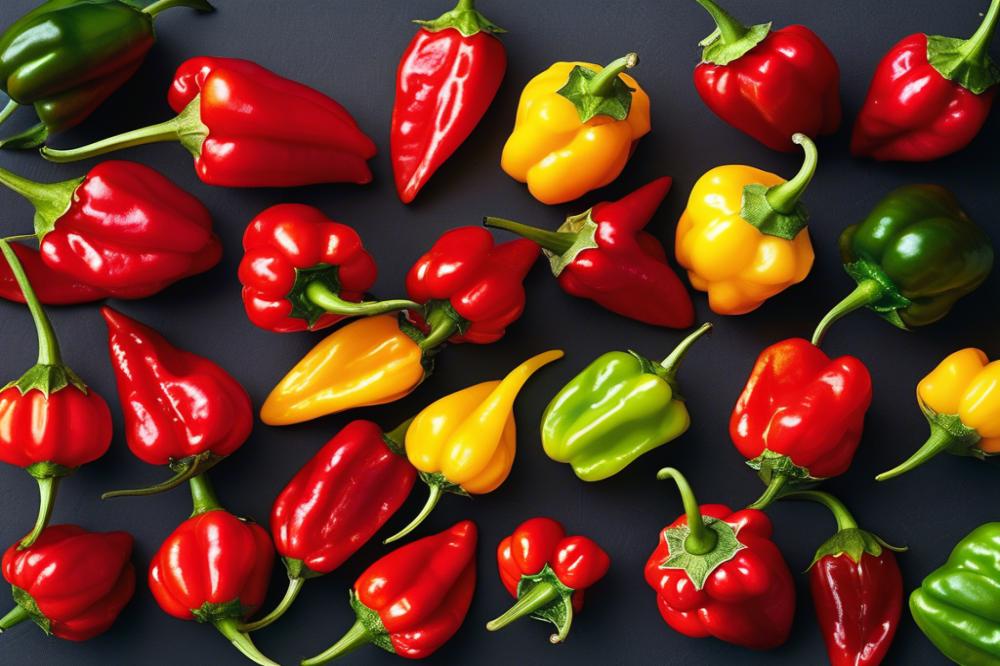Introduction
For heat enthusiasts, the allure of spicy peppers goes beyond mere taste. Trinidad Scorpion Peppers, known for their fiery heat and distinctive flavor, hold a special place in the hearts of those who crave something extraordinary. These peppers are not just another addition to the gardening palette; they embody the challenge and thrill of growing hot peppers.
Understanding the basics of capsicum chinense is essential for anyone venturing into this exciting world. This plant species is famous for producing some of the hottest varieties around, including the famed Trinidad Scorpion. The heat tolerance of these peppers can be staggering, measured in Scoville heat units that often leave seasoned spice lovers gasping for relief.
Those who dive into the world of superhot peppers discover a thrilling journey filled with care and cultivation challenges. Proper pepper care, including abundant sunlight and well-drained soil, is vital for a successful harvest. gardening tips from experienced growers often include strategies for pest control and the importance of regular hydration. Each stage, from planting seedlings to harvesting peppers, requires attention and diligence.
In conclusion, growing Trinidad Scorpion Peppers and other spicy varieties offers a unique experience that combines gardening with culinary excitement. For those willing to embrace the heat, the rewards can be both delicious and fulfilling.
Understanding Trinidad Scorpion Peppers


Origin and History
Trinidad Scorpion peppers trace their origins back to Trinidad and Tobago. This pepper variety has a fascinating history, deeply tied to the culture of the Caribbean islands. Farmers there have cultivated these spicy peppers for generations. A significant milestone occurred in 2011 when it gained recognition as one of the hottest peppers in the world. gardening tips from seasoned growers often emphasize the importance of local conditions in achieving optimal heat levels. Sunshine, humidity, and soil composition play critical roles in developing the pepper’s characteristic fire.
Heat Level and Scoville Scale
On the Scoville scale, the heat level of Trinidad Scorpion reaches a staggering 1.4 million units and can sometimes surpass 2 million. This range places it among the hottest superhot peppers available today. For heat enthusiasts, understanding the Scoville scale is essential when choosing peppers. Many enjoy comparing heat levels as a fun way to explore their limits. Tolerance to heat varies widely from person to person, so starting with caution is wise.
Comparison with Other Spicy Peppers
When compared to other peppers like the Jalapeño or Habanero, the Trinidad Scorpion is far more explosive in taste. Jalapeños usually clock in at about 2,500 to 8,000 Scoville units, while Habaneros can reach up to 350,000. Differences in heat levels can be striking, creating an exciting spectrum for fans of spicy foods. This wide range caters to various taste preferences, allowing people to experiment with different cultivation methods. Those who dare to cultivate these peppers should learn about proper pepper care to control the experience effectively.
Unique Flavor Profile
The flavor profile of Trinidad Scorpion is as intense as its heat. Many describe it as fruity with subtle undertones, making it a favorite ingredient in hot sauces. The balance of sweetness and heat can enhance many dishes, from salsas to marinades. Enjoying the pepper’s flavor can be just as thrilling as its fiery kick. While growing them, consider how their flavor can be showcased in various culinary creations. Pest control becomes essential to maintain the health of the plants, ensuring a robust harvest. Timing plays a key role in harvesting peppers, which is best done when they are ripened to perfection.
Preparing for Cultivation


Choosing the Right Location
Finding the perfect spot for growing Trinidad Scorpion peppers is crucial. These spicy peppers thrive in warm conditions and require plenty of sunlight. A location that receives at least six hours of direct sunlight each day is ideal. Avoid shady areas, as they may impede growth and reduce heat levels. Good air circulation around the plants can also help keep them healthy. Consider proximity to sources of water and ensure the area is easily accessible for maintenance and harvesting.
Soil Requirements and Amendments
Soil quality directly affects pepper cultivation. Well-draining soil is a must to prevent root rot. A pH level of 6.0 to 7.0 is preferred. Before planting, enriching your soil with organic matter like compost can significantly improve fertility. Some gardeners also recommend adding lime or sulfur to adjust pH levels if necessary. Regular testing can help fine-tune soil conditions and promote healthy growth.
Planning for Heat Tolerance
Understanding heat tolerance is essential when growing superhot peppers like the Trinidad Scorpion. These plants can endure high temperatures but may struggle if it’s too hot for prolonged periods. Your strategy should involve regular watering, especially during hot spells. Mulch can help retain soil moisture and maintain root temperature. Recognizing early signs of stress, such as browning leaves, allows for timely intervention.
Selecting Seeds or Seedlings
Choosing the right seeds is a critical step in pepper care. Select high-quality seeds from reputable suppliers for the best results. If you prefer convenience, consider purchasing healthy seedlings. Look for plants that are robust and free of pests. Remember to select varieties that suit your growing conditions. Starting seeds indoors several weeks before the last frost date can improve your chances of a successful crop. Once you have your seeds or seedlings, you are ready to begin this spicy adventure.
Gardening Tips for Successful Growth


Optimal Planting Times
Timing is crucial for growing these spicy peppers. Start seeds indoors about 8-10 weeks before the last frost. The warmth from the soil helps germination. Once temperatures remain consistently above 70°F, transplant seedlings outdoors. This usually fits well into a late spring schedule. Be mindful of your local climate. Placing your peppers in the ground too early can stunt their growth.
Watering and Fertilizing Practices
Maintaining moisture is essential for healthy plants. Watering deeply and less frequently promotes strong root development. Early morning is the best time to water the plants. Fertilization should start when seedlings begin to grow. Use a balanced fertilizer that promotes flowering and fruiting. Reduce the frequency as the plants mature. Pay attention to the signs of nutrient deficiency, like yellowing leaves. Adjust your fertilizing approach as needed for optimal pepper care.
Sunlight and Temperature Considerations
Superhot peppers thrive in bright sunlight. Aim for at least six to eight hours of direct sun each day. This helps the plants develop their signature heat. Keep them in a spot that avoids strong winds. Night temperatures shouldn’t fall below 60°F. When both daytime and nighttime temperatures remain warm, peppers grow best. Provide shade during intense heat to prevent sunscalding. Your goal is to create the perfect environment for the plants.
Pruning and Shaping the Plants
Regular pruning encourages bushier growth. Remove the lower leaves to promote airflow and reduce disease. Pinching off the flower buds early can lead to larger fruits later. Use clean, sharp scissors to make clean cuts. Shaping the plants helps them stay healthy. Inspect regularly for any signs of pests or diseases. Implement a pest control strategy to minimize damage. Healthy plants produce better yields, especially when harvesting peppers.
Pepper Care and Maintenance


Regular inspection for health is crucial when growing superhot peppers. Check plants frequently for signs of wilting or discoloration. Keeping a close eye helps catch problems early. Strong plants tend to produce more vibrant fruit.
Watering Schedules and Techniques
Watering peppers requires balance. Too much moisture can lead to root rot, while too little can cause stress. Aim to water deeply, but less often. Once the top inch of soil dries out, it’s time to water again. Morning is the best time for this task, allowing leaves to dry throughout the day.
Pest Control Methods
Pests can be a challenge in pepper cultivation. Aphids and spider mites often target vulnerable plants. Use natural solutions like neem oil or insecticidal soap. Spraying these products early in the morning or late in the evening minimizes harm to beneficial insects. Homemade traps can also catch pesky bugs.
Dealing with Diseases in Chili Plants
Diseases can hinder growth and affect yields. Common issues include blight and powdery mildew. Keeping plants spaced well apart promotes airflow, which reduces humidity around the foliage. If you notice symptoms, removing affected leaves is essential. In some cases, treating soil with beneficial microorganisms can help restore plant health.
Harvesting Trinidad Scorpion Peppers
Identifying the Right Ripeness
Knowing when to pick is crucial for flavor and heat. Fully ripe Trinidad Scorpion peppers usually display vibrant colors, often turning from green to a bright red or orange. A pepper that is glossy and seems firm indicates it is ready for harvest. Look for any signs of wrinkling or dark spots. These can signal over-ripeness or decay, suggesting it’s better to pick while still firm. Heat-seekers appreciate these spicy peppers at their peak, as this is when they boast the highest Scoville rating.
Techniques for Proper Harvesting
When the time comes to start harvesting peppers, use sharp scissors or pruning shears. Cutting the stem close to the fruit helps prevent damage to the plant. Gently twist and pull can also work, but caution is key to avoid breaking the branches. Always wear gloves. The oils from superhot peppers can cling to skin and cause a burning sensation. It’s wise to stagger your harvest to prolong the growing season; this way, pepper cultivation continues even as some plants mature.
Storage Tips for Fresh Peppers
After harvesting, proper storage is important for extending freshness. Store peppers in the refrigerator to keep them crisp and flavorful. A breathable bag or paper towel can help maintain moisture without trapping humidity. They will usually last up to two weeks in the fridge if cared for properly. For longer-term storage, consider freezing. Slice the peppers and pack them in airtight containers. This method helps preserve their heat tolerance for cooking later.
Using Harvested Peppers in Cooking
Incorporating freshly harvested Trinidad Scorpion peppers into recipes can elevate any dish. These fiery delights can spice up sauces, marinades, or even salsas. Start with just a small piece when experimenting with their heat level, as they are extremely potent. Using them in homemade hot sauce is also popular among heat enthusiasts. Blending with vinegar and garlic yields an authentic kick. Remember, moderation is vital, as these peppers pack a punch that can overwhelm less daring eaters.
Final Thoughts on Cultivating Heat
The Trinidad Scorpion is one of the hottest peppers in the world. Its distinctive flavor and extreme heat make it a favorite among spicy pepper enthusiasts. Those who love culinary adventures will find joy in growing this fiery fruit in their own gardens.
Heat seekers should definitely consider cultivating this remarkable pepper. With some patience and care, anyone can enjoy the thrill of harvesting their own spicy treasures. Plus, the process of gardening can be incredibly rewarding. Watching your plants grow, nurturing them, and eventually tasting their fruits can become a passionate hobby.
For success, embrace a few important gardening tips. Start with healthy seeds, provide ample sunlight, and keep an eye on watering. Balancing these aspects will boost your chances of a fruitful harvest. Passion and persistence are key in this thrilling gardening journey.
Remember, sharing your hot creations with friends can deepen your enjoyment of the experience. Everyone can appreciate the unique flavors these fiery fruits bring to their meals. Whether you use them in sauces, salsas, or simply as a seasoning, they can elevate any dish.
In closing, growing these spicy peppers can be a great adventure for anyone willing to embark on it. Cultivate your love for gardening and heat, and share your successes with fellow enthusiasts. Your spicy pepper journey has just begun!



